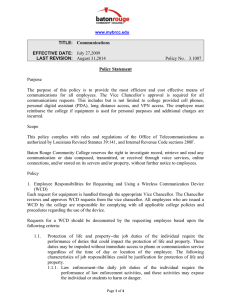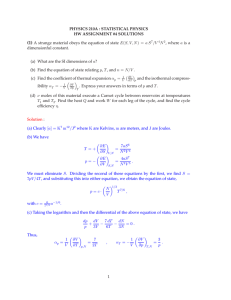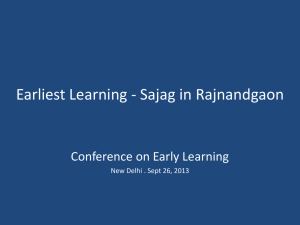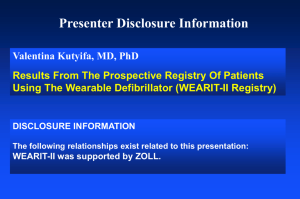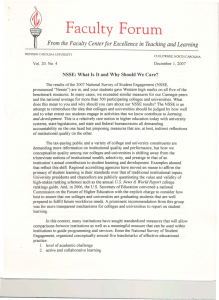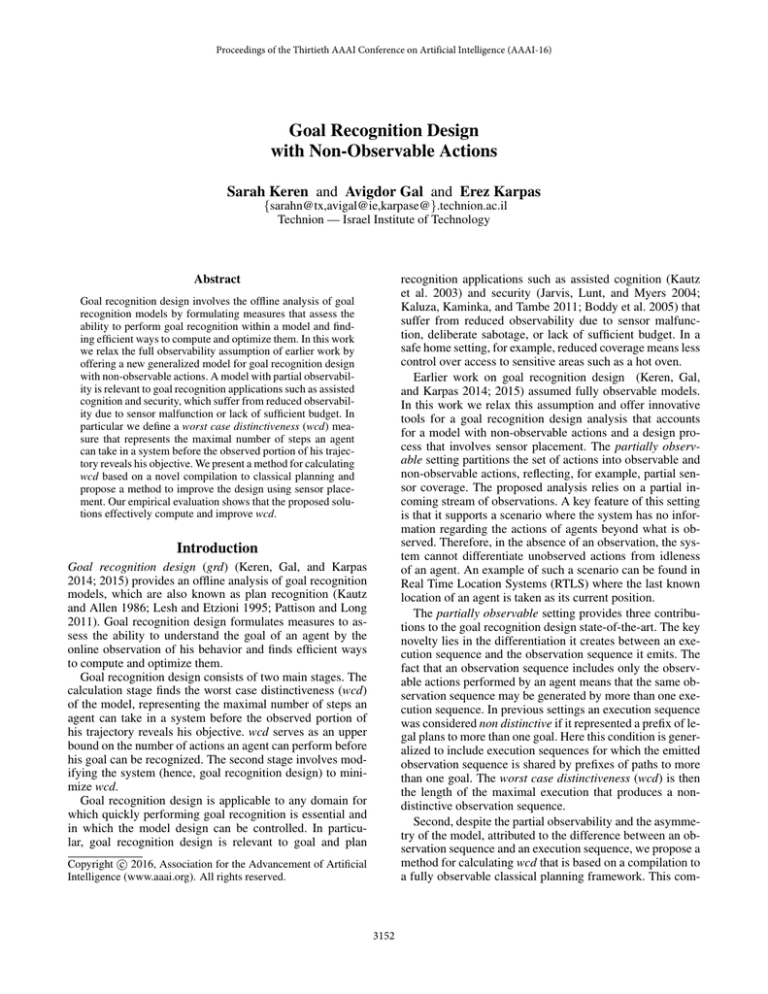
Proceedings of the Thirtieth AAAI Conference on Artificial Intelligence (AAAI-16)
Goal Recognition Design
with Non-Observable Actions
Sarah Keren and Avigdor Gal and Erez Karpas
{sarahn@tx,avigal@ie,karpase@}.technion.ac.il
Technion — Israel Institute of Technology
recognition applications such as assisted cognition (Kautz
et al. 2003) and security (Jarvis, Lunt, and Myers 2004;
Kaluza, Kaminka, and Tambe 2011; Boddy et al. 2005) that
suffer from reduced observability due to sensor malfunction, deliberate sabotage, or lack of sufficient budget. In a
safe home setting, for example, reduced coverage means less
control over access to sensitive areas such as a hot oven.
Earlier work on goal recognition design (Keren, Gal,
and Karpas 2014; 2015) assumed fully observable models.
In this work we relax this assumption and offer innovative
tools for a goal recognition design analysis that accounts
for a model with non-observable actions and a design process that involves sensor placement. The partially observable setting partitions the set of actions into observable and
non-observable actions, reflecting, for example, partial sensor coverage. The proposed analysis relies on a partial incoming stream of observations. A key feature of this setting
is that it supports a scenario where the system has no information regarding the actions of agents beyond what is observed. Therefore, in the absence of an observation, the system cannot differentiate unobserved actions from idleness
of an agent. An example of such a scenario can be found in
Real Time Location Systems (RTLS) where the last known
location of an agent is taken as its current position.
The partially observable setting provides three contributions to the goal recognition design state-of-the-art. The key
novelty lies in the differentiation it creates between an execution sequence and the observation sequence it emits. The
fact that an observation sequence includes only the observable actions performed by an agent means that the same observation sequence may be generated by more than one execution sequence. In previous settings an execution sequence
was considered non distinctive if it represented a prefix of legal plans to more than one goal. Here this condition is generalized to include execution sequences for which the emitted
observation sequence is shared by prefixes of paths to more
than one goal. The worst case distinctiveness (wcd) is then
the length of the maximal execution that produces a nondistinctive observation sequence.
Second, despite the partial observability and the asymmetry of the model, attributed to the difference between an observation sequence and an execution sequence, we propose a
method for calculating wcd that is based on a compilation to
a fully observable classical planning framework. This com-
Abstract
Goal recognition design involves the offline analysis of goal
recognition models by formulating measures that assess the
ability to perform goal recognition within a model and finding efficient ways to compute and optimize them. In this work
we relax the full observability assumption of earlier work by
offering a new generalized model for goal recognition design
with non-observable actions. A model with partial observability is relevant to goal recognition applications such as assisted
cognition and security, which suffer from reduced observability due to sensor malfunction or lack of sufficient budget. In
particular we define a worst case distinctiveness (wcd) measure that represents the maximal number of steps an agent
can take in a system before the observed portion of his trajectory reveals his objective. We present a method for calculating
wcd based on a novel compilation to classical planning and
propose a method to improve the design using sensor placement. Our empirical evaluation shows that the proposed solutions effectively compute and improve wcd.
Introduction
Goal recognition design (grd) (Keren, Gal, and Karpas
2014; 2015) provides an offline analysis of goal recognition
models, which are also known as plan recognition (Kautz
and Allen 1986; Lesh and Etzioni 1995; Pattison and Long
2011). Goal recognition design formulates measures to assess the ability to understand the goal of an agent by the
online observation of his behavior and finds efficient ways
to compute and optimize them.
Goal recognition design consists of two main stages. The
calculation stage finds the worst case distinctiveness (wcd)
of the model, representing the maximal number of steps an
agent can take in a system before the observed portion of
his trajectory reveals his objective. wcd serves as an upper
bound on the number of actions an agent can perform before
his goal can be recognized. The second stage involves modifying the system (hence, goal recognition design) to minimize wcd.
Goal recognition design is applicable to any domain for
which quickly performing goal recognition is essential and
in which the model design can be controlled. In particular, goal recognition design is relevant to goal and plan
c 2016, Association for the Advancement of Artificial
Copyright Intelligence (www.aaai.org). All rights reserved.
3152
action is a triple a = pre(a), add(a), del(a), which represents the precondition, add, and delete lists respectively,
all are subsets of F . An action a is applicable in state s if
pre(a) ⊆ s. If action a is applied in state s, it results in a
new state s = (s \ del(a)) ∪ add(a). C : A → R+
0 is a cost
function that assigns each action a non-negative cost.
The objective of a planning problem is to find a plan π =
a1 , . . . , an , a sequence of actions that brings an agent from
I to a goal state. The cost c(π) of a plan π is Σni=1 (C(ai )).
Often, the objective is to find an optimal solution for P , an
optimal plan, π ∗ , that minimizes the cost. We assume the
input of the problem includes actions with a uniform cost of
1. Therefore, plan cost is equivalent to plan length, and the
optimal plans are the shortest ones.
Figure 1: A partially observable goal recognition design
problem
pilation allows us to exploit existing efficient tools for calculating wcd. Our empirical analysis shows that the compilation allows efficient computation of wcd.
The third contribution of this work involves finding an
optimal set of modifications that can be introduced to
the model in order to reduce wcd. We introduce a new
design-time modification method that involves exposing
non-observable actions, e.g., by (re)placing sensors. This
modification method is used, in addition to removing actions
from the model (Keren, Gal, and Karpas 2014), to minimize
wcd while respecting restrictions on the number of allowed
modifications. The empirical analysis reveals that the combination of these two types of modifications leads to greater
improvements than each of the measures separately.
Model
A model for partially observable goal recognition design
(grd-po) is given as D = PD , GD , Πleg (GD ) where:
• PD = FD , ID , AD is a planning domain where AD =
AoD ∪ Ano
D is a partition of AD into observable and nonobservable actions, respectively.
• GD is a set of possible goals, where each possible goal
g ∈ GD is a subset
of FD .
• Πleg (GD ) = g∈GD Πleg (g) is the set of legal plans to
each of the goals. A plan is an execution of actions that
take the agent from I to a goal in GD . A legal plan is
one that is allowed under the assumptions made on the
behavior of the agent.
The grd-po model divides the system description into three
elements: system dynamics, defined by PD and GD , agent
strategy defined by Πleg (GD ), and observability defined by
the partition of AD into AoD and Ano
D . Whenever D is clear
from the context we shall refrain from adding the subscript.
Whereas a plan π is a full execution, a path is a prefix
D)
of a legal plan. We denote the set of paths in D as Π(G
and the set of paths that are prefixes of plans achieving goal
In the partially observable setting the obg ∈ GD as Π(g).
servation sequence that is produced by a path includes only
the observable actions that are performed. Accordingly, an
observation sequence o = a1 , · · · , an is a sequence of actions aj ∈ Ao . For any two action sequences a1 , · · · , an and a1 , · · · , am the concatenation of the action sequences
is denoted by a1 , · · · , an · a1 , · · · , am .
The relationship between a path and an observation sequence is formally defined next.
Example 1 To illustrate the objective of calculating and
optimizing wcd of a goal recognition design model, consider Figure 1, which demonstrates a simplified setting from
the logistics domain. There are 3 locations, Loc1 , Loc2 and
Loc3 , a single truck that is initially located at Loc1 , and 3
objects that are initially placed such that O1 and O2 are at
Loc1 , and O3 is at Loc2 . Objects can be moved by loading
them (L) onto the truck and unloading them (U L) in their
destination after the truck reaches it using a drive action
(D). There are two possible goals, g0 : O1 at Loc2 and O2
and O3 at Loc3 , and g1 : O1 at Loc3 and O3 at Loc1 . Optimal plans are the only valid plans in this example.
In the fully observable setting (see Figure 1(left)) wcd = 1
since O1 needs to be loaded on the truck for both goals to
be achieved. The goal is revealed by the next action, which
can either be L(O2 ) for g0 or D(Loc1 , Loc2 ) for g1 .
In Figure 1(right)), the loading depot is covered. Therefore, all load and unload actions are non-observable and
the only observable actions are those that relate to the movements of the truck. Since the truck needs to travel from Loc1
to Loc2 and then to Loc3 for achieving both goals, the goal
is revealed only if D(Loc3 , Loc1 ) is performed. This means
that g0 can be achieved without the system being aware of it
(wcd = 8). Exposing L(O2 ), by placing a sensor on the object, changes the situation dramatically by reducing wcd to
its value in the fully observable setting.
Definition 1 Given a path π , the observable projection of π
in D, denoted opD (π ) (op(π ) when clear from the context),
is recursively defined as follows:
Background
The basic form of automated planning, referred to as classical planning, is a model in which the actions of agents
are fully observable and deterministic. A common way to
represent classical planning problems is the STRIPS formalism (Fikes and Nilsson 1972): P = F, I, A, G, C where
F is a set of fluents, I ⊆ F is the initial state, G ⊆ F represents the set of goal states, and A is a set of actions. Each
opD (
π) =
⎧
⎪
⎪
⎨
⎪
⎪
⎩
if π = a1 · opD (a2 · · · an )
if π = a1 , · · · , an and a1 ∈ Ao
D
opD (a2 , · · · , an )
if
π = a1 , · · · , an and a1 ∈ Ano
D
It is worth noting that the fully observable setting (Keren,
Gal, and Karpas 2014; 2015) is a special case in which the
entire action set is observable. In this case, Ano = ∅, Ao =
3153
A, and the observable projection of any action sequence is
equivalent to the action sequence itself.
The relation between a path and a goal and an observation
sequence and a goal are defined as follows.
Next, we define the measure by which we evaluate a
model. The worst case distinctiveness (wcd) of a grdpo model represents the maximal number of steps an agent
can advance in a system without revealing his goal. We mark
nd (D) and define
the set of non-distinctive paths in D as Π
nd (D).
wcd as maximal length of paths in Π
Definition 4 The worst case distinctiveness of a model D,
denoted by wcd(D) is:
Definition 2 A path π satisfies a goal g if π ∈ Π(g).
An observation sequence o satisfies a goal g if ∃π ∈ Π(g)
s.t. o = op(π ).
For example, L(O1 ), L(O2 ), D(Loc1 , Loc2 ) in Example 1, hereon referred to as πex1 , satisfies only g0 . However,
its observable projection op(πex1 ) = D(Loc1 , Loc2 ) satisfies both go and g1 .
A
O
(π ) and GD
(op(π )) represent the set of goals
We let GD
that are satisfied by the executed path π and its observable projection op(π ), respectively. The distinction the grdA
O
po model creates between GD
(π ) and GD
(op(π )) is a key
element of the proposed framework. More generally, we examine the effect of concealing an action by making it nonobservable (that is, moving it from Ao to Ano ) on the number of goals the observable projection of a path satisfies. The
fact that concealment may only increase the number of goals
will be fundamental in our analysis of the grd-po model.
Theorem 1 Let D and D be two grd-po models that are
no
D ),
π ∈ Π(G
identical except that Ano
D ⊆ AD . For any wcd(D) =
max |π |
nd (D)
π ∈Π
The distinction the grd-po model creates between the set of
goals a path satisfies and the set of goals satisfied by its observable projection affects the way wcd can be calculated. To
find the wcd of a model D one needs to account for all paths
D (G) that satisfy at least one goal (1 ≤ |G A (π )|)
π ∈ Π
D
and whose observable projection satisfies at least two goals
O
(2 ≤ |GD
(op(π ))|). This requirement promotes an analysis that partitions the set of valid paths according to the
goals they satisfy, and examines each group separately be nd (gi ) represent the
fore combining the results. We let Π
non-distinctive paths of gi , i.e., the non-distinctive paths that
are prefixes of legal plans to gi . We define wcd-gi as the
maximal wcd shared by goal gi and any other goal.
Definition 5 The worst case distinctiveness of a goal gi in
model D, denoted by wcd-gi (D) is:
O
O
GD
(op(π )) ⊆ GD
π ))
(op(
Proof: According to Definition 1, the observation sequence
generated by the execution of a path π is op(π ) =
a1 , ..., an where ai ∈ Ao . If ∀a ∈ π , a ∈ Ano
\
D
(
Ano
then
op
(
π
)
=
op
π
)
since
none
of
the
acD
D
D
tions in π changed their observability property. Therefore,
O
O
GD
(op(π )) = GD
π )). Otherwise, ∃ai ∈ π , 1 ≤ i ≤ n
(op(
no
s.t. ai ∈ Ano
\ AD . According to Definition 1,
D
opD (π ) = opD (a1 , ..., ai−1 · ai · opD (ai+1 , ..., an )
whereas
opD (π ) = opD (a1 , ..., ai − 1 · opD (ai+1 , ..., an ).
For any path π that is identical to π except that ai is replaced
by a possibly empty sequence of non-observable actions,
opD (π ) = opD (π ) but opD (π ) = opD (π ). Since π may
O
O
(op(π )) ⊆ GD
π )).
lead to a different goal than π , GD
(op(
Our analysis is based on the discovery of paths whose observable projection does not reveal the goal of the executing agent, i.e., of paths whose observable projection satisfies
more than one goal. Accordingly, we define non-distinctive
observation sequences and paths as follows.
wcd-gi (D) =
max |π |
nd (gi )
π ∈Π
The wcd of the entire model can be found by taking the maximum over individual results for wcd-gi (D).
Theorem 2 Given a grd-po model D,
wcd(D) = max(wcd-gi (D)).
i
nd (D) s.t. |π | >
Proof: Assume to contrary that ∃π ∈ Π
max(wcd-gi (D)). According to Definition 5, ∃gi ∈ G s.t.
i
nd (gi ) but |π | > wcd-g (D), which serves as a conπ ∈ Π
i
tradiction to the definition of wcd-gi (D).
A key issue to notice is that in the partially observable setting we lose the convenient symmetry that existed in the fully observable setting in which wcd-g0 =
wcd-g1 = wcd for any pair of goals g0 , g1 . In Example 1, wcd(D) = wcd-g0 (D) = wcd-g1 (D) = 1 for
the fully observable setting since π = Load(O1 ) is
nd (g0 ) and Π
nd (g1 ). In the partially observable
both in Π
setting, wcd(D) = wcd-g0 (D) = 8 > wcd-g1 (D) =
5 since the maximal non-distinctive path πwcd-ex1 =
L(O1 ), L(O2 ), D(Loc1 , Loc2 ), L(O3 ), U L(O1 ),
D(Loc2 , Loc3 ), U L(O2 ), U L(O3 ) satisfies g0 but not g1.
Definition 3 o is a non-distinctive observation sequence if
it satisfies more than one goal. Otherwise, it is distinctive.
π is a non-distinctive path if its observable projection o =
op(π ) is non-distinctive. Otherwise, it is distinctive.
The path πex1 (Example 1) is non-distinctive since its observable projection satisfies both g0 and g1 . Lemma 1, given
next, sets the relationship between a path and its prefixes
(The proof is omitted due to space restrictions).
Calculating wcd
The baseline method for wcd calculation is a breadth first
search through the space of paths. A search node (path) is
pruned if it does not represent a prefix of a legal plan, or if it
is distinctive. In order to determine if a path π is distinctive
Lemma 1 Any prefix of a non-distinctive path is nondistinctive.
3154
• I = {f0 , f1 | f ∈ I}}
e
• A = A0,1 ∪ Ane
i ∪ Ai ∪ {DoExpose} ∪ {Donei }
– A0,1 = {{f0 , f1 | f ∈ pre(a)} ∪ {¬exposed},
{f0 , f1 | f ∈ add(a)},
{f0 , f1 | f ∈ del(a)} | a ∈ A}
– Ane
i = {{fi | f ∈ pre(a)} ∪ {¬exposed},
{fi | f ∈ add(a)},
{fi | f ∈ del(a)} | a ∈ Ano }
– Ae0 = {{f0 | f ∈ pre(a)} ∪ {exposed} ∪ {¬done0 },
{f0 | f ∈ add(a)},
{f0 | f ∈ del(a)} | a ∈ A}
– Ae1 = {{f1 | f ∈ pre(a)} ∪ {exposed} ∪ {done0 },
{f1 | f ∈ add(a)},
{f1 | f ∈ del(a)} | a ∈ A}
– Done0 = exposed, done0 , ∅
– DoExpose = ∅, exposed, ∅
• G = {f0 |f ∈ g0 } ∪ {f1 |f ∈ g1 }
⎧
⎪
2 − if a ∈ A0,1
⎪
⎪
⎪
⎪
⎨1 − if a ∈ Ane
0
• C (a) =
e
⎪
if a ∈ Ane
⎪
1 , Ai
⎪1
⎪
⎪
⎩
0
if a ∈ {DoExpose} ∪ {Done0 }
we can solve a goal recognition problem and remove a node
whose observable projection satisfies more than one goal.
While the BFS method supports any possible set of legal
plans, the need to solve a separate goal recognition problem for each node makes this method inefficient. Next, we
present a classical planning compilation used to calculate the
wcd more efficiently in the case of optimal and boundedly
suboptimal (reaching a goal with a bounded cost beyond optimal) legal plans. The compilation finds the maximal nondistinctive path shared by a goal pair. We use it to calculate
wcd-gi by pairing gi to each of the other goals. Relying on
Theorem 2 we find the wcd of the model by combining individual results to find the maximal value over wcd-gi . For
the sake of clarity, the following description focuses on settings where the set of legal plans is the set of optimal plans.
The extension to boundedly suboptimal case (Keren, Gal,
and Karpas 2015) will follow the compilation description.
The wcd of each goal pair G = {g0 , g1 }, denoted by
wcd-g0,1 , is found by solving a single planning problem
P involving two agents (agent0 and agent1 ) each with a
copy fi of F . Both agents start at the same initial state (I )
but each aim at a goal gi . The solution to the problem is
a plan (for both agents), divided into two parts by a common exposure point. The prefix of the plan up to the exposure point represents a non-distinctive path, one that does
not reveal the goal of both agents and may consist of actions
performed by both agents simultaneously (denoted A0,1 ) in
addition to non-observable actions performed by one of the
agents (Ane
i ). The exposure point is represented by exposed,
which is a fluent representing the no-cost action DoExpose
has occurred. After the exposure point the goal of the agent
is recognized. The actions, either observed or non-observed,
performed by a single agent after the exposure point are denoted by Aei . Since our objective is to reveal the maximal
non-distinctive path of the model, we discount the cost of
actions that belong to unexposed prefixes of plans, encouraging the agents to extend the unexposed prefix.
The use of the exposure point is similar to the use of
split (Keren, Gal, and Karpas 2014; 2015), where agents are
encouraged to act together. However, the addition of nonobservable actions to the unexposed prefix breaks the symmetry that existed in the fully observable setting. The objective is no longer to find a path that maximizes the number of steps both agents share (actions in A0,1 ). Rather, one
of the agents seeks a path that keeps the agent unrecognized by combining non-observable actions (actions in Ane
i )
and observable actions that are on legal paths to a different
goal (actions in A0,1 ). To reflect this asymmetry we change
the objective to allow only one agent (arbitrarily chosen as
agent0 ) to benefit from the discount assigned to performing
non-observable actions.
The latest-expose compilation (Definition 6) finds
wcd-g0,1 for optimal agents for each pair of goals {g0 , g1 }.
Note that after agent 0 accomplishes its goal, Done0 is performed, allowing the application of actions in Ae1 until g1 is
achieved. We force agent 1 to wait until agent 0 reaches its
goal before starting to act to make the search for a solution
to P more efficient by removing symmetries between different interleaving of agent plans after DoExpose occurs.
Accounting for the bounded-non optimal agent setting
(with a cost Bi ) requires constraining the path lengths of
each agent to be C ∗ (gi )+Bi (Keren, Gal, and Karpas 2015).
This is achieved by adding an action counting mechanism
to the model such that each action aki advances the counter
of the corresponding agent. Both counters are initialized to
0 and each agent’s goal requires performing C ∗ (gi ) + Bi
actions. We also add idlei actions, which only advance the
counter, to support settings in which an agent cannot reach
the goal in exactly C ∗ (gi ) + Bi steps. The cost of idlei is
the same as regular actions and can only be performed after
exposed becomes true as to not effect the wcd value.
Given a solution πP to P , we mark the projection of
πP on each agent i as πP (gi ), which includes all actions
e
in A0,1 , Ane
i , and Ai that appear in πP . Accordingly, the
projection of the optimal solution πP∗ to P on each agent
is marked as πP∗ (gi ). We guarantee that πP∗ (gi ) yields a legal plan for both agents in D by bounding , the discount
that may be collected for performing actions before DoExpose occurs, to be lower than the smallest possible diversion
from a legal path to any of the agents. Accordingly, whenever < min(C ∗ (g0 +B10 ),C ∗ (g1 +B1 )) , both agents act opti
D
D
mally in P (Keren, Gal, and Karpas 2015).
Next, we show that the observable projection of the paths
prior to the exposure point is non-distinctive. Given a solution πP , unexposed(πP (gi )) denotes the prefix of πP (gi )
prior to the exposure point.
Lemma 2 unexposed(πP (gi )) is non-distinctive.
Proof: To show that unexposed(πP (gi )) is non-distinctive
we need to show that it satisfies both g0 and g1 .
The compilation guarantees that for any action a ∈
Definition 6 For a grd-po problem D = P, G =
{g0 , g1 }, Πleg (G) where P = F, I, A = Ao ∪ Ano we
create a planning problem P = F , I , A , G , with action costs C , where:
• F = {f0 , f1 | f ∈ F } ∪ {exposed} ∪ {done0 }
3155
unexposed(πP (gi )), a ∈ A0,1 or Ano
i . According to
Definition 1, op(unexposed(πP (gi ))) = {a1 ...an |a ∈
A0,1 }. This means that op(unexposed(πP (g0 ))) =
op(unexposed(πP (g1 )) and according to Definition 3,
op(unexposed(πP (gi )) is non-distinctive.
Finally, Theorem 3 shows that the optimal solution to P yields the wcd-g0 , thus concluding our proof of correctness.
Theorem 3 Given a grd-po model D with two goals
g0 , g1 and a model P , created according to Definition 6,
wcd-g0 (D) = |unexposed(πP∗ (g0 ))|.
Proof: We have described the bound on that guarantees
that, apart from the no-cost operation DoExpose and Done0 ,
the solution to P consists solely of actions that form a
pair of legal paths to each of the goals. Therefore, among
the solutions that comply with this condition, πP∗ is the
one that maximizes the accumulated discount. The compilation guarantees that the only way to accumulate discount is by maximizing the number of actions agent0 performs before the exposure point, therefore πP∗ is the solution to P that maximizes |unexposed(πP (g0 ))|. Therefore
|unexposed(πP∗ (g0 ))| = wcd-g0 (D).
In Example 1, πwcd-ex1 sets the wcd to be 8. Using our calculation, πwcd-ex1 is represented by unexposed(πP∗ (g0 ))
in which L(O1 ) is performed by both agents (and belongs
to A0,1 ), L(O2 ) is unobserved (Ane
0 ), D(Loc1 , Loc2 ) and
L(O3 ) are performed together (A0,1 ), U L(O1 ) is unobserved, D(Loc2 , Loc3 ) is performed together(A0,1 ), and finally U L(O2 ) and U L(O3 ) are both unobserved (Ane
0 ).
search tree is therefore represented by a pair Arem , Asen .
A node is pruned from the search if any of the constraints
have been violated or if there are no more actions to add.
The key question remaining is what are the modifications
that should be considered at each stage. A naı̈ve approach
would be to consider all possible modifications, which is
impractical and wasteful. Instead, we focus our attention on
modifications that have the potential of reducing wcd by either eliminating the wcd path (action removal) or by reducing the length of its non-distinctive prefix (exposure). Ac wcd(D) represent the path
cording to Definition 4, we let Π
set π s.t. π = argmax |π |. In addition, Πwcd(D) represents
nd (D)
π ∈Π
wcd(D) as their prefix. It
the set of plans that have a path in Π
was already shown that the only actions that need to be considered for elimination are the actions that belong to plans in
Πwcd(D) (Keren, Gal, and Karpas 2014). We show that the
only actions that need to be considered for exposure are the
wcd(D) .
non-observable actions that appear in paths in Π
Theorem 4 Let D and Dt be two grd-po models that are
no
no
no
identical except that Ano
Dt ⊆ AD . If ∀a ∈ AD \ ADt , a ∈
wcd(D) then wcd(D) = wcd(Dt ).
Π
Proof: Theorem 1 assures that any distinctive path in D re nd (Dt ) ⊆ Π
nd (D). Since the
mains distinctive in Dt and Π
wcd value of a model is determined by the maximal length of
nd then wcd(Dt ) ≤ wcd(D). We need to show
the paths in Π
that under the specified conditions, the wcd cannot decrease
in Dt . Assume to the contrary that wcd(Dt ) < wcd(D).
nd (D)
This means that there is a non distinctive path π ∈ Π
s.t. π is a maximal non-distinctive path in D and is distinc wcd(D) and π ∈ Π
nd (D) \ Π
nd (Dt )).
tive in Dt (i.e., π ∈ Π
no
Definition 1 guarantees that since ∀a ∈ AD \ Ano
Dt , a ∈
wcd(D) , the observable projection did
wcd(D) then ∀π ∈ Π
Π
nd (Dt ),
not change opD (π ) = opDt (π ) and therefore π ∈ Π
which serves as a contradiction.
The reduction algorithm creates, for each node, one successor for disallowing each action that appears in Πwcd (D) and
one successor for exposing each non-observable action in
wcd(D) found by the calculation performed at
the path π ∈ Π
the parent node. To avoid redundant computation, we cache
computed actions combination.
In Example 1, disallowing actions is impossible without
increasing the optimal costs. However, by exposing L(O2 )
by placing a sensor on O2 , wcd is reduced to 1, the same as
in the fully observable setting.
Reducing wcd
Having formulated the wcd measure, we turn to our second
objective of finding ways to optimize wcd by redesigning
the model. Optimization can be achieved using two possible modifications, namely action removal and exposure. The
former disallows actions from being performed while the latter exposes actions by moving them from Ano to Ao , e.g., by
placing a new sensor.
wcd reduction is performed within a modification budget that represents the constraints to be respected by the reduction method. Given the two possible modifications of a
model, we can either provide an integrated budget, Btotal ,
or separate budgets Bsep = Brem , Bsen , where Brem and
Bsen are the bounds on the number of actions that can be
removed and exposed, respectively.
Our objective is to minimize the wcd value of the model,
subject to a budget constraint. We mark the modifications
by a pair Arem , Asen , where Arem and Asen are the disallowed and exposed actions in the transformed model, respectively. In our exploration we assume a uniform cost for
the removal and exposure of all actions. In addition, we force
the cost of achieving any of the goals to not increase. Both
simplifying assumptions can be easily relaxed without major
modification to the reduction algorithm.
The reduction is performed using a BFS search that iteratively explores all possible modifications to the model. The
initial state is the original model and each successor node
introduces a single modification, either exposure or reduction, that was not included in the parent node. A node in the
Empirical Evaluation
Our empirical evaluation has several objectives. Having
shown that reduced observability may increase wcd we first
examine empirically the extent of this effect. In addition,
we compare the efficiency of methods proposed for the
fully observable (Keren, Gal, and Karpas 2014) and partially observable settings. Finally, we evaluate the reduction process as well as the effectiveness of action reduc-
3156
GRID
GRID+
BLOCK
LOG
latest-split
Time wcd
0%
Time wcd
Time
wcd
0.32
3.53
3.03
238.5
(0.9)
0.32
8.75
29.2
165.2
(0.6)
0.36
9.56
33.2
153.26
(0.31)
10.41
3.55
2.12
3.71
10.36
3.45
2.06
3.51
5%
10.36
3.45
2.06
3.71
10%
Time
wcd
0.35
9.64
25.89
155.48
(0.29)
20%
Time wcd
10.46
3.67
2.14
3.78
0.36
9.96
31.01
191.56
(0.2)
out, we mark in parentheses the ratio of solved instances.
For all domains, wcd increases with the increase in the ratio of non-observable actions. As for running time, latestsplit outperforms the equivalent partially observable setting
for all domains except GRID, for which performance is similar. However, the overhead for adding non-observable actions is negligible. For the LOG-Generated domain the increase in wcd was more noticeable, with the average wcd increasing from 3.77 in the fully observable setting to 4.87 in
the partially observable setting.
Table 2 summarizes the results for wcd reduction for the
partially observable setting for each ratio, showing for each
budget allocation the average wcd reduction achieved within
the allocated time (for the LOG domain results refer only to
the problems that were successfully solved in the wcd calculation stage). The evaluation shows that for all domains
wcd can be decreased by applying at least one of the modification methods separately, but the most substantial reduction
is achieved by combining the methods. Note that this observation is relevant to the entire domain, while individual instances used one modification form. We intend to investigate
this phenomenon in future work. For the LOG-Generated
domain the results for the reduction went from 4.87 in the
original partially observable setting to 3.34, 3.9 and 3.8 for
the 4,0, 4,4, 0 bound allocations, respectively.
11.1
3.84
2.82
4.1
Table 1: Average running time and values for wcd calculation over solved problems for varying non-observable actions ratio
GRID
GRID+
BLOCK
LOG
5%
4:0
0
4
10.41
3.55
2.12
3.71
9.64
2.01
1.78
3.37
9.71
2.01
1.83
3.44
10 %
4:0
0:4
0
4
10.36
3.55
2.12
3.56
10.46
3.67
2.14
3.78
9.34
1.75
1.58
3.26
9.76
1.87
1.64
3.42
20 %
4:0
0:4
0
4
10.36
2.93
2.1
3.51
11.1
3.84
2.82
4.1
10.91
2.6
2.15
3.47
11.1
2.92
2.45
3.8
0:4
10.91
3.35
2.67
3.67
Table 2: Average wcd after reduction for each ratio and budget allocation achieved within allocated time
tion vs. exposure. We describe the datasets and the experiment setup before presenting and discussing the results.
Datasets We use 4 domains of plan recognition (Ramirez
and Geffner 2009), namely G RID -NAVIGATION(GRID),
IPC-G RID+ (GRID+), B LOCK - WORDS(BLOCK), and L O GISTICS (LOG). Each problem description contains a domain description, a template for a problem description without the goal, a set of goals and a set of non-observable actions. For each benchmark we generated a separate grd problem for each pair of hypotheses and randomly sampled actions to form the non-observable set creating 3 instances
with 5%, 10% and 20% randomly chosen non-observable
actions. We tested 216 GRID instances, 660 GRID+ instances, 600 BLOCK instances, and 300 LOG instances.
In addition, we created a hand crafted benchmark for the
L OGISTICS domain dubbed LOG-Generated, which corresponds to Example 1 where packages load and unload actions are non-observable. This corresponds to real-world settings where satellite imaging can easily track movement of
vehicles between locations, but the actual actions performed
are obscured from view.
Setup For each problem instance we calculate wcd and runtime for the fully observable and partially observable settings. For wcd reduction we examine the partially observable setting with 3 bound settings: an integrated bound of
Btotal = 4 and 2 separate bounds 0, 4 and 4, 0, where
the first element of each pair represents Brem and the second Bsen . We used the Fast Downward planning system
(Helmert 2006) running A∗ with the LM-CUT heuristic
(Helmert and Domshlak 2009). The experiments were run
on Intel(R) Xeon(R) CPU X5690 machines, with a time
limit of 30 minutes and memory limit of 2 GB.
Results Table 1 summarizes the impact the ratio of nonobservable actions has on execution time and wcd. The partially observable setting is partitioned into the various ratios examined, including a problem with no non-observable
actions, which is compared against the values collected for
the fully observable setting solved using latest-split. For
each setting we compare average run time (in seconds) over
solved problems. Whenever some of the problems timed-
Related Work
Goal recognition design was first introduced by Keren et
al. (2014; 2015), offering tools to analyze and solve the
grd model in fully observable settings. This work relaxes
the full observability assumption.
The first to establish the connection between the closely
related fields of automated planning and goal recognition
were Ramirez and Geffner (2009), presenting a compilation
of plan recognition problems into classical planning problems. Several works on plan recognition followed this approach (Agotnes 2010; Pattison and Long 2011; Ramirez
and Geffner 2010; 2011) by using various automated planning techniques. We follow this approach as well and introduce a novel compilation of goal recognition design problems with non observable actions into classical planning.
Partial observability in goal recognition has been modeled
in various ways (Ramirez and Geffner 2011; Geib and Goldman 2005; Avrahami-Zilberbrand, Kaminka, and Zarosim
2005). In particular, observability can be modeled using a
sensor model that includes an observation token for each action (Geffner and Bonet 2013). Note that the grd-po model,
presented for the partially observable setting, can be thought
of as one in which the set of observation tokens O includes
an empty observation sequence o∅ and A includes a no-cost
action aidle by which an agent remains at his current position.
Conclusions
We presented a goal recognition design model that accounts
for partial observability by partitioning the set of actions
to observable and non-observable actions. We extend the
wcd measure and proposed ways to calculate and reduce it.
3157
Kautz, H.; Etzioni, O.; Fox, D.; Weld, D.; and Shastri, L.
2003. Foundations of assisted cognition systems. University of Washington, Computer Science Department, Technical Report.
Keren, S.; Gal, A.; and Karpas, E. 2014. Goal recognition
design. In ICAPS Conference Proceedings.
Keren, S.; Gal, A.; and Karpas, E. 2015. Goal recognition
design for non optimal agents. In Proceedings of the Conference of the American Association of Artificial Intelligence
(AAAI 2015).
Lesh, N., and Etzioni, O. 1995. A sound and fast goal
recognizer. In Proceedings of the Fourteenth International
Joint Conference on Artificial Intelligence (IJCAI 1995),
volume 95, 1704–1710.
Pattison, D., and Long, D. 2011. Accurately determining
intermediate and terminal plan states using bayesian goal
recognition. Proceedings of the First Workshop on Goal,
Activity and Plan Recognition(GAPRec 2011) 32.
Ramirez, M., and Geffner, H. 2009. Plan recognition as
planning. In Proceedings of the Twenty-First International
Joint Conference on Artificial Intelligence (IJCAI 2009).
Ramirez, M., and Geffner, H. 2010. Probabilistic plan recognition using off-the-shelf classical planners. In Proceedings
of the Conference of the American Association of Artificial
Intelligence (AAAI 2010).
Ramirez, M., and Geffner, H. 2011. Goal recognition over
pomdps: Inferring the intention of a pomdp agent. In Proceedings of the Twenty-Second International Joint Conference on Artificial Intelligence- Volume Three (IJCAI 2011),
2009–2014. AAAI Press.
By accounting for non-observable actions, we increase the
model’s relevancy to a variety of real-world settings.
Our empirical evaluation shows that non-observable actions typically increases the wcd value. In addition, we
showed that for all of the domains, wcd reduction using both
disallowed and exposed actions is preferred over each of the
methods separately.
References
Agotnes, T. 2010. Domain independent goal recognition.
In Stairs 2010: Proceedings of the Fifth Starting AI Researchers Symposium, volume 222, 238. IOS Press, Incorporated.
Avrahami-Zilberbrand, D.; Kaminka, G.; and Zarosim, H.
2005. Fast and complete symbolic plan recognition: Allowing for duration, interleaved execution, and lossy observations. In Proc. of the AAAI Workshop on Modeling Others
from Observations, MOO.
Boddy, M. S.; Gohde, J.; Haigh, T.; and Harp, S. A. 2005.
Course of action generation for cyber security using classical planning. In Proceedings of the Fifteenth International
Conference on Automated Planning and Scheduling (ICAPS
2005), 12–21.
Fikes, R. E., and Nilsson, N. J. 1972. Strips: A new approach
to the application of theorem proving to problem solving.
Artificial intelligence 2(3):189–208.
Geffner, H., and Bonet, B. 2013. A concise introduction
to models and methods for automated planning. Synthesis Lectures on Artificial Intelligence and Machine Learning
8(1):1–141.
Geib, C. W., and Goldman, R. P. 2005. Partial observability
and probabilistic plan/goal recognition. In Proceedings of
the International workshop on modeling other agents from
observations (MOO-05).
Helmert, M., and Domshlak, C. 2009. Landmarks, critical
paths and abstractions: What’s the difference anyway? In
Gerevini, A.; Howe, A. E.; Cesta, A.; and Refanidis, I., eds.,
Proceedings of the 19th International Conference on Automated Planning and Scheduling, ICAPS 2009, Thessaloniki,
Greece, September 19-23, 2009. AAAI.
Helmert, M. 2006. The fast downward planning system. J.
Artif. Intell. Res. (JAIR) 26:191–246.
Jarvis, P. A.; Lunt, T. F.; and Myers, K. L. 2004. Identifying
terrorist activity with ai plan recognition technology. In Proceedings of the Sixteenth National Conference on Innovative
Applications of Artificial Intelligence (IAAI 2004, 858–863.
AAAI Press.
Kaluza, B.; Kaminka, G. A.; and Tambe, M. 2011. Towards
detection of suspicious behavior from multiple observations.
In AAAI Workshop on Plan, Activity, and Intent Recognition
(PAIR 2011).
Kautz, H., and Allen, J. F. 1986. Generalized plan recognition. In Proceedings of the Fifth National Conference of the
Amercan Association of Artificial Intelligence (AAAI 1986),
volume 86, 32–37.
3158


